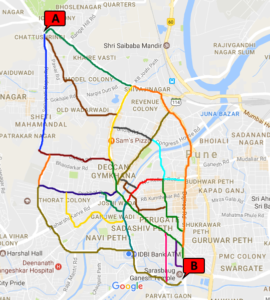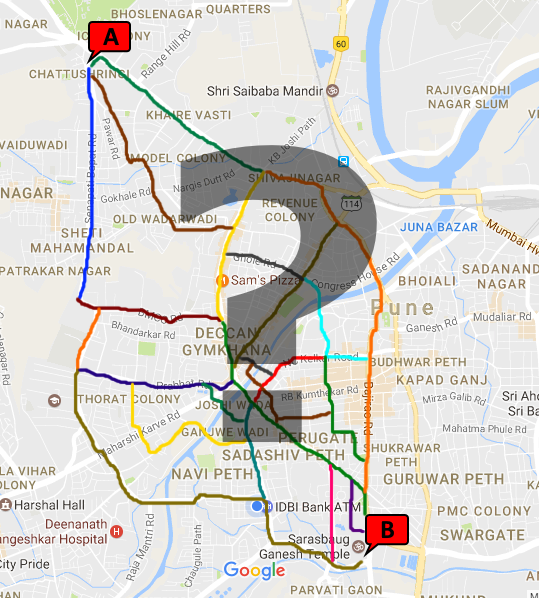Walking and driving on the road has become so commonplace in our lives that, sometimes we don’t even recognize it while we are doing! Every moment on the streets, we make choices and decisions which are results of a very complex algorithms running in our brain. Right algorithms! I know it sounds too much Math but I will explain in this blog that algorithm is not only about Math.
Algorithm is the manifestation of Mathematics and theories combined together working in sync to generate a logical conclusion.
Let’s take a common example that your pickup point is A and destination is B. Now, there can be lots of different ways to reach your destination. You have a GPS with you and also this is your usual travel through the city. Let’s see following picture which shows many routes you can take to reach destination B from A. Please note that, this is just a sample map to prove a point. Which one would you choose?Well, the answer can as simple as ‘Just follow the GPS’! But, if you are clever and are used to this travel you will think twice before blindly following the GPS. Why? That’s the real question. It’s not because we don’t trust GPS. GPS is a fantastic tool but finally it’s a tool like all others. Then what is it that asks us to question GPS result and think if there is any better alternative? .. Instinct! Yes, it’s our instinct that forces us to think and to doubt. Machines and artificial devices are very powerful and may be more powerful than brightest human’s brain. But, it lacks one thing ‘Imagination’. Of course you can build up database for AI (Artificial Intelligence) but you can’t make machine to think. Because, the whole basis of the machine is to work on known data or calculated data based on known data. Imagination works on unknown and sometimes speculative data. That’s where human brain wins the race when it comes to innovation. I agree, that speculations and instincts can be wrong but,
‘Failure is the cost you have to pay if you want to innovate and every failure adds up very important data into our brain’s database, which will be used in the future endeavors‘
Yet, everyday we apply this imagination to make decisions on the streets and if you think of it it’s no lesser than an innovation and then discovery.

Let’s see how a thinking brain works in the situation mentioned above. We need to begin at A and reach B and let’s assume we have N number of options or routes. The GPS ideally will show the route which will take you to B in least time, the fastest route. But, is it the whole reality about being efficient? No. So, sometimes we choose a different route than the one given by GPS. Because, fastest is not always the best. Apart from being faster the efficient route must also be comfortable. Yes, didn’t really think of it right? But, we do think of it in our subconscious. So, we eliminated some routes from our bucket and we are left with M routes. That’s why even though a route is fastest we avoid it to choose second fastest route because the fastest route is full of potholes and dirt! So, we established that apart from speed, comfort is also important. But, wait.. the decision making doesn’t end here.
We took care of speed and comfort, but, is it not possible that there can be tolls on the M routes we chose out of N options? So, it is natural to add cost of journey into our consideration of efficiency. Hence we eliminate some more routes which have tolls and we are left with L routes. Hence, we have three criteria or parameters for efficiency speed, comfort and cost. Fantastic, still we have L routes left, and we have to choose the best route. (Slowly we shifted from fastest route to best route. Remember definition of best is subjective.) We are yet ignoring another important aspect, the vehicle, or the resource so as to say. So depending upon the resource or the vehicle we can filter out some of the routes, because, practically speaking some routes may not allow one type of the vehicle or other. In other words the resources may not be fit for some of the routes. So, for given vehicle we are left with P number of routes. Finally, we ended up with criteria or parameters for efficiency as speed, comfort, cost, resources. You must be thinking, that is it we got everything figured out!
No! we yet have to add in another important criteria to add to our efficiency norm ‘Time‘. Yes, anyone who has been travelling in between those given points A and B knows that the traffic conditions, road conditions never remain same all the time, if the condition of road of a route is bad today, it’s not necessary it will stay so all the time. You may be travelling in a different vehicle next day. So, all the criteria mentioned above are bound to change according to day of the week, time of the day and other time based events like festivals, social events and sometimes unaccounted public ceremonies (like processions in a wedding in India.) And this is where machines fall behind human brain. Imagination! We can fill in the data to a machine, even if the data is real time there is no guarantee that there will be a pattern to the traffic. There is no pattern. Have you ever said to yourself that, ‘this weekend’s traffic is smoother than last weekend? how?’. The reason is nature’s randomness, unpredictability. So to put in mathematical terms, the function for efficiency becomes
Equation of Efficiency = E(ƒ( Speed(t), Resource(t), Comfort(t), Cost(t), Events(t)) )(t)
And, based on all the criteria and their effects and our experience (database) we take certain decisions on the future predictions about the conditions to choose the ‘Best‘ route. This is how nature works, this is what evolution has done to human brain. Each calculation in the brain adds up to our most precious asset, Experience!
Isn’t this startling? that for a simple journey from A to B we make all these calculations mentioned above plus imagination to come to right conclusion. This is what I call an algorithm, which I mentioned above in bold letters. Think of this in a corporate world. For any project, there will always a staring point and always an end point or at least a definitive transit point. Any analytically oriented person will tell you that, getting to the end point or the transit point faster is not the right or the best route. For the approach to accomplish the goal of the project, the path has to fulfill all the criteria we talked about. I hope you will agree with me, that the path will be chosen based on the speed, cost, comfort/ease of use, available resources and time management and all these parameters available at disposal at any given moment, individual and team’s experience and most important imagination. Without imagination, no one can develop an out of box solution. (If you choose a path that solves only current problems then rest assured that your solution will fail for the problems that have not come up yet). If you think you failed, don’t worry keep trying, keep thinking. So, best of luck and keep watching and observing while on the streets.
Finding the right and efficient approach to solve a problem or develop a solution can be as simple or straight forward as finding the best route that will take you home. Fails the one who tries, spectators and rat racers will never see the victory
